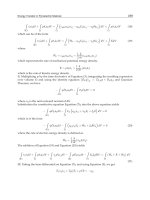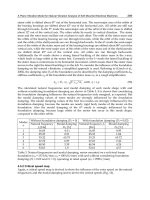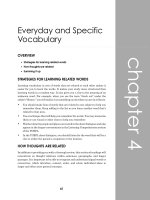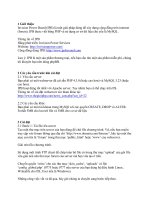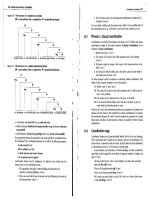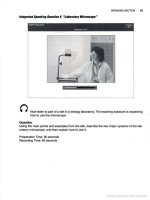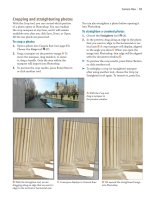MARKETING RESEARCH PART 11 pps
Bạn đang xem bản rút gọn của tài liệu. Xem và tải ngay bản đầy đủ của tài liệu tại đây (448.15 KB, 36 trang )
Designing the
Questionnaire
What is a Questionnaire?
• A questionnaire is the vehicle used to
pose the questions that the
researcher wants respondents to
answer.
Ch 11
2
Questionnaire Design
• Questionnaire design is a systematic
process in which the researcher
contemplates various question
formats, considers a number of
factors characterizing the survey at
hand, ultimately words the various
questions very carefully, and
organizes the questionnaire’s layout.
Ch 11
3
The Functions of a
Questionnaire
• Translates the research objectives
into specific questions
• Standardizes those questions and the
response categories
• Fosters cooperation and motivation
• Serves as permanent records of the
research
Ch 11
4
The Functions of a
Questionnaire
• Can speed up the process of data
analysis
• Can serve as the basis for reliability
and validity measures
Ch 11
5
Steps in the Questionnaire
Development Process (Figure 11.1)
Ch 11
6
Developing Questions
• Question development is the practice
of selecting appropriate response
formats and wording questions so
that they are understandable,
unambiguous, and unbiased.
Ch 11
7
Developing Questions
• Marketing research questions
measure
– Attitudes
– Beliefs
– Behaviors
– Demographics
Ch 11
8
How wording affects answers
Did you see…
Which generates
more agreement?
A broken headlight?
The broken headlight?
Ch 11
9
Words to Avoid in
Questionnaire Development
•
•
•
•
•
•
•
Ch 11
All
Always
Any
Anybody
Ever
Every
Never
10
Why Avoid These Words?
• These words: all, any, anybody, best,
ever, every, never, etc. are all
EXTREME ABSOLUTES…
• They place respondents in a situation
where they must either fully agree or
they must completely disagree with the
extreme position in the question.
– Do you always observe traffic signs?
– Would you say all cats have four
Ch 11
11
legs?
Four “Do’s” of Questionnaire
Wording
• Question evaluation refers to
scrutinizing the wording of a question
to ensure the question is not biased
and is worded such that respondents
understand it and can respond to it
with relative ease.
Ch 11
12
Four “Do’s” of Questionnaire
Wording
1.The question should be focused on a
single issue or topic. “What type of
hotel do you stay in on a trip?”
Pleasure or business trip? En route
or final destination?
2.The question should be brief.
3.The question should be
grammatically simple, if possible.
4.The question should be crystal clear.
Ch 11
13
Four “Do Not’s” of
Questionnaire Wording
1.The question should not “lead” the
respondent to a particular answer.
“Don’t you see any problem with
using credit cards for online
purchases?”
2.The question should not have
“loaded” wording or phrasing. Use
universal beliefs…Since our
Founding Fathers gave us the right to
Ch 11 bear arms…
14
Four “Do Not’s” of
Questionnaire Wording
3.The question should not be “doublebarreled.”
4.The question should not use words
that overstate the condition…do not
use “dramatics.” “Would you buy
sunglasses that protect your eyes
from harmful ultraviolent rays that
cause blindness?”
Ch 11
15
What is wrong with each question?
How do you feel about Sears?
When some gasoline or electric-powered product
in your house breaks, do you call the Sears repair
service?
If the Sears repair service schedule was not
convenient for you, would you consider or not
consider calling a competing repair organization
to fix the problem you have?
How much do you think you would have to pay to
have Sears fix something that needs to be
repaired?
Shouldn’t concerned parents use car seats?
Should car seats be used for our loved ones?
Do good parents and responsible citizens use car
seats?
Ch 11
Do you believe infant car seats can protect riders
from being maimed?
16
Individual Question Wording
• “Do’s” for all questions
– Keep it focused on a single topic
Please rate feel aspect of Sears…
How do youeach about Sears?
– Keep it brief
If you did not use Sears repair service, product in your house
When some gasoline or electric-poweredwould you use another
repair do you
breaks,service?call the Sears repair service?
– Keep it grammatically simple
If the Searsneed it, service schedule was not convenient for you,
When you repair do you call Sears repair service?
would you consider of not consider calling a competing repair
organization to fix the problem you have?
– Keep it crystal clear
Ch 11
How much do you think you would haveforpay to have Sears fix
much do you think Sears charges to a repair service
call?
something that needs to be repaired?
17
Individual Question Wording
• “Do not’s” for all questions
– Don’t ask leading questions
Do you think infant car seats are useful?
Shouldn’t concerned parents use car seats?
– Don’t ask loaded questions
Do you think car seats for our loved family
Should car seats be usedare useful for ones? members?
– Don’t ask double-barreled questions
Do you think parents who use car seats use car seats?
good parents and responsible citizens are responsible?
– Don’t use overstated questions
Do you believechildren’s car seats are useful? from being maimed?
you think infant car sears can protect riders
Ch 11
18
Questionnaire Organization
• Questionnaire organization is the
sequence of statements and
questions that make up the
questionnaire.
• It is important because the
questionnaire appearance and ease
of flow affect the quality of the
information gathered.
Ch 11
19
Questionnaire Organization
• The introduction is called a “cover
letter” if the introduction is written to
accompany a mail survey or online
survey.
Ch 11
20
Questionnaire Organization
• Five functions:
– Identifies the surveyor/sponsor
– Indicates the purpose of the survey
– Explains how the respondent was
selected
– Requests for/provides incentive for
participation
– Determines if respondent is
suitable
Ch 11
21
Questionnaire Organization
Ch 11
22
Incentives
• Incentives are offers to do something
for the respondent to increase the
probability that the respondent will
participate in the survey.
Ch 11
23
Incentives
• Incentives may be monetary or nonmonetary.
– Anonymity: respondent assured
name not identified
– Confidentiality: respondent’s name
is known by the researcher but not
divulged to a third party
– Both are used as non-monetary
incentives to increase participation
Ch 11
24
Screening Questions
• Screening questions are used to
ferret out respondents who do not
meet research study qualifications.
• Research objectives should specify
who should and should not be
included in the research study.
Ch 11
25
